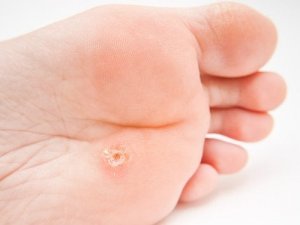Plantar Warts: Characteristics and Treatment

Plantar warts are the result of a viral infection caused by direct contact with the common human papillomavirus. The virus lodges in the first two layers of the skin – the dermis and epidermis – but it never reaches the deeper layers.
The term “papilloma” refers to the infections caused by this viral strain. However, when it infects feet, then the bumps are called plantar warts. These come in different shapes and sizes and, depending on the extent of the lesion, they may last up to 8 months.
There are two types of plantar warts. On the one hand, there’s a single wart that often increases in size. It can multiply on rare occasions, forming additional ones, known as satellites.
The other type of plantar wart is the mosaic-type wart. This is a group of several small warts that grow close together in the same area and are more difficult to treat than lone warts.
The Symptoms of Plantar Warts
The growth of warts is deep and slow. However, it gives rise to a series of signs and symptoms such as:
- Thick skin: Plantar warts often resemble a callus due to their thick and hard tissue.
- Pain: While walking or simply standing.
- Small black spots often appear on the surface of the wart. These are the dried blood that stays in the capillaries.
Diagnosis of Plantar Warts

A doctor will examine a person’s foot to diagnose a plantar wart. The professional will pinch the lesion to see if there is pain during the exam. This is because plantar warts are painful when pinched. There’s no pain if you put pressure on them, however. When a wart is coated with keratin, you may be bothered if you press the area.
Another option for diagnosis is to cut the lesion with a scalpel and check for signs of small dark spots. Also, a dermatologist can remove part of the lesion to perform a biopsy.
Treatments for Plantar Warts
Most plantar warts are harmless and disappear without treatment. However, it often takes between one to two years. Nevertheless, it’s common to have to repeat the treatment several times until they disappear.
Unfortunately, there’s always the possibility that they’ll reappear. Next, we’ll tell you about some of the treatments you can do to eliminate plantar warts.
Exfoliation with salicylic acid
Salicylic acid treatments work by removing the wart layers little by little. They can also help boost the immune system’s ability to fight warts.
Cryotherapy

Freezing or cryotherapy is a form of treatment that’s usually performed at a clinic. It consists of applying liquid nitrogen directly to the wart with a swab or a spray. After application, a blister will form around the wart. Then, after a week, the dead tissue will come off.
Most likely, you’ll have to repeat the treatment every two weeks until the wart disappears. Some studies indicate that cryotherapy is more effective if combined with salicylic acid-based treatments.
You may be interested: Get Rid of Warts with This Garlic-Lemon Treatment
Surgery and other treatment alternatives
If the above treatments aren’t effective, a physician may recommend one of the following procedures:
- An application of trichloroacetic acid to the plantar wart with a wooden stick every week. The doctor may indicate to alternate it with salicylic acid. Itching may appear as side effects of this treatment.
- A small surgery by cutting the wart or destroy it with an electric needle. This process is known as curettage or electrodesiccation. Note that curettage will leave scars, and it’s not commonly used unless the other treatments aren’t effective.
- They may also do laser treatment with a pulsed laser to burn the small closed blood vessels. Then, over time, the infected tissue will die and the wart will fall off. You should repeat the laser treatment every three to four weeks. Do keep in mind that this procedure is painful and will possibly leave a scar.
As a complementary measure, keep in mind that if any pressure on a plantar wart causes you pain, then you can wear padded footwear to get relief. Also, stay away from tight and uncomfortable shoes and wear shoes with good support on the sole.
All cited sources were thoroughly reviewed by our team to ensure their quality, reliability, currency, and validity. The bibliography of this article was considered reliable and of academic or scientific accuracy.
- Cobián, P., Monteagudo, B., Mosquera-Fernández, A., & Peña-López, S. (2018). Verruga plantar anular en un paciente tratado con un anti-factor de necrosis tumoral alfa. Piel.
- Moreno Cano, P., Agüero Orgaz, D., & Duce Tello, S. (2011). Verruga plantar: Lesión benigna pero dolorosa. FMC Formacion Medica Continuada En Atencion Primaria.
- López López, D., Rodríguez Sanz, D., Morales Ponce, Á., & Soriano Medrano, A. (2013). Carcinoma verrucoso plantar. A propósito de un caso poco frecuente. Revista Internacional de Ciencias Podológicas.
-
Sánchez Gómez, Rubén. Flores Olavarría, Macarena. Revisión bibliográfica sobre la eficacia terapéutica de la crioterapia y el laser en el tratamiento de la verruga plantar provocada por el virus del papiloma humano. European Journal of Podiatry, 2016, 2 (2): 69-76 ISSN: 2445-1835
This text is provided for informational purposes only and does not replace consultation with a professional. If in doubt, consult your specialist.








